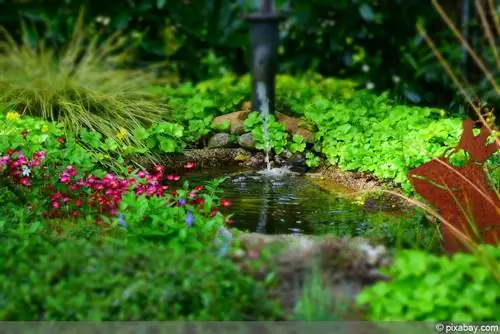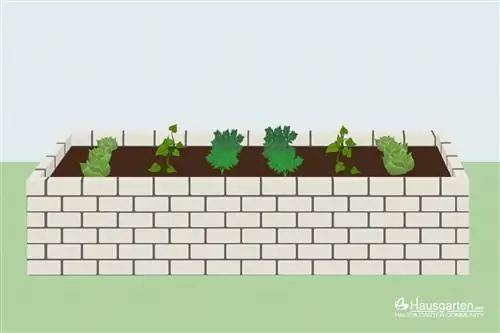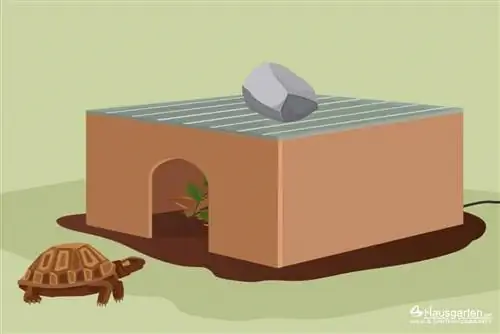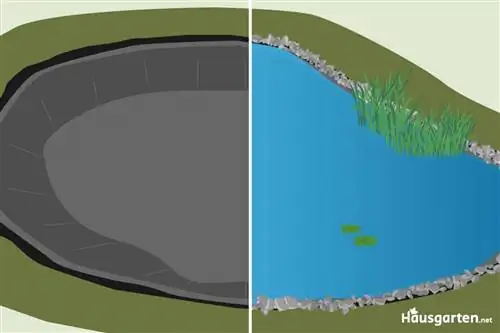- Author admin [email protected].
- Public 2023-12-17 03:39.
- Last modified 2025-01-24 12:45.
If you want to enjoy the soothing sound of a stream in your own garden on warm summer evenings, you will find valuable tips for making your own in this guide.
Which type of concrete is best?
Although prefabricated concrete shells are already available in stores, since these are mainly plastic imitations, do-it-yourselfers should use liquid concrete, which can be individually modeled. In this regard, there are several types of concrete, all of which have different properties:
- Floating concrete: very soft material that spreads independently after pouring
- Screed concrete: Concrete for making floors, ideal for thin layers of concrete
- Mineral concrete: is considered a very high quality material because it has a very high proportion of broken grain, is used in road construction and serves as a base for terraces, has good binding properties and is very robust
- Exposed concrete: Visually appealing if the surface is visible and is not covered with natural stone
- barrier concrete: waterproof material
- Vacuum concrete: very dense material, less cracking due to removal of water content
The concrete mixture also differs in terms of its consistency. For the construction of a stream, we recommend concrete mass that is mixed on site. Examples of possible options are:
- In-situ concrete: is made on the job and hardens quickly
- Fresh concrete: available in different haptics (stiff, plastic, soft and flowable, the latter type being the most suitable)
Note:
After the concrete has been made, it still needs to be made waterproof. The do-it-yourselfer either mixes sealing powder from the hardware store into the mixture or covers the casting with thick mud or liquid pond liner. Only when the concrete mass has dried is water allowed to flow into the stream bed.
Another advantage of liquid concrete is that no tamping device is required to compact it. Compacting can be done with poking. The purpose of the process is to allow air to escape from the mass so that no cavities are formed into which liquid can later penetrate. If the concrete mass has pores inside, it is particularly susceptible to frost.
Planning
With careful planning, even on the smallest plot of land you can find a spot for a waterfall. However, the watercourse always has priority when it comes to space. The rest of the design of the garden (beds, etc.) should be based on the stream and not the other way around. Since curves and junctions can be easily laid with concrete blocks, do-it-yourselfers can extend the length to just a few square meters.
Tip:
In order to get a precise idea of what will happen later, we recommend tensioning a rope. This help is particularly useful when concreting, as no changes are possible afterwards.
To create a harmonious look, the length and width should be adapted to the size of the property. While narrow streams often drown in large gardens, wide systems look out of place in small garden areas.
Although do-it-yourselfers do not necessarily have to stick to specified dimensions, the following values have proven to be average optimal dimensions:
- optimal width: 0.2 to 1.5 m
- Minimum depth: 25 cm
- Minimum length: 1.5 m
Do-it-yourselfers should also choose a spot in partial shade. When exposed to direct sunlight, a lot of water evaporates and algae forms. However, trees should not shade the garden pond as the falling leaves destroy the look and contaminate the water.
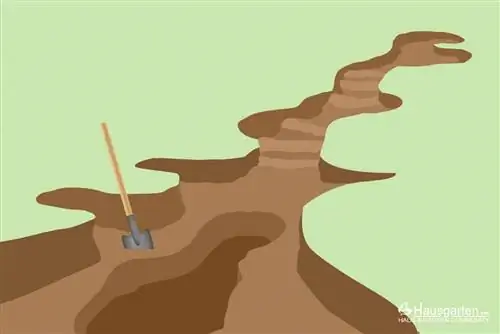
In addition, when choosing a location and the flow speed of the water, it is important to take into account that stagnant water attracts mosquitoes. A small stream next to the terrace is a visual and acoustic enrichment, but it also has the disadvantage of many insects if the water only flows moderately into the garden pond. A waterfall, on the other hand, destroys the surface tension and prevents mosquitoes from settling on the stream to breed.
Tools and materials
In order to lay a stream on your home property, do-it-yourselfers have three different methods to choose from. The following list of advantages illustrates why concrete blocks are a worthwhile alternative to conventional foil or plastic stream trays.
- high leak resistance
- weather-resistant
- durable
- suitable for any decoration
A disadvantage compared to the alternatives mentioned is that discrepancies cannot be remedied after concreting. A foil to line the riverbed is necessary in any case.
Once the planning has been completed, the do-it-yourselfer pours the concrete into the appropriate mold. To pour concrete he needs the following tools:
- Spade or mini excavator (depending on the depth of the waterfall)
- Garden or hedge trimmer
- cutter knife
- Wood panel
- gravel
- Spirit level
- Pond fleece
- Mortar
- Water pump
- compatible pressure hose (suitable for the length of the stream)
- Sand for filling
- waterproof safety clothing (work gloves, rubber boots, etc.)
- Suitable concrete mass
Tip:
If the excavated material is to be reused for later design, it is worth renting a container. For small quantities, a simple tarpaulin serves as storage option.
The gradient
So that the water flows independently, a constant gradient of around 2% to 5% is necessary. The value determines the flow speed at which the water masses splash into the garden pond. Even if nature does not provide a suitable gradient, a standstill can be avoided with just a few interventions. It makes more sense to move the stream deeper into the earth than to build a hill. For this purpose, the do-it-yourselfer places the river bed about 15 cm to 20 cm deeper into the ground.
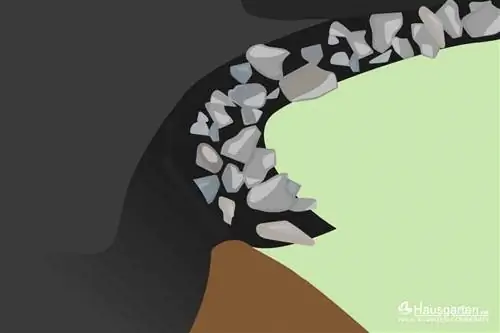
However, the stream must not be too steep, otherwise the water will fall too quickly, taking decorations and small creatures with it. Here too, there are empirical values that guarantee a consistent flow rate. The norm is: About 1.5 liters of water per minute should flow into the collecting basin per centimeter of width.
If the slope is too steep, there are several ways to flatten the gradient:
- Integrate steps and routes into the stream
- expand the width
- deepen the stream bed
- Install obstacles such as stepping stones
- Installing bends
The catch basin
Most streams flow into a small pond. This can also be replaced by a tiny collecting basin consisting of a plastic bowl, as long as it has enough capacity to install the pump. The size of the catch basin must correspond to the amount of water flowing down to avoid flooding. To do this, the do-it-yourselfer is guided by the above-mentioned guideline.
The construction instructions
- mark the planned route with wooden sticks
- remove the turf or top layer of soil at this point
- dig out the stream bed starting at the source
- work from top to bottom of the garden pond
- Install desired steps
- remove all roots from the stream bed
- compact the soil well
- Lay a wooden board over the stream and check for straightness using a spirit level
- Sprinkle the course with sand
- Spread pond fleece
- Place the foil over it and smooth it out (it must protrude slightly at the edges)
- Bend the excess film with the fleece underneath into an S shape so that a small depression is created at the edge of the bank
- fill this with gravel
- mix the concrete and pour it into the stream bed (note the note)
- immediately get into shape
- cut off any excess pond liner with the cutter knife
- Place the pipe at the source and secure it with mortar
- Fill the stream with gravel, fix with mortar if necessary
- repair unsightly spots on the edge of the bank
- Place the pump approx. 80 cm deep in the collecting basin
- Create pipe connection to the mouth
- Let water in and check whether it overflows the banks at any point
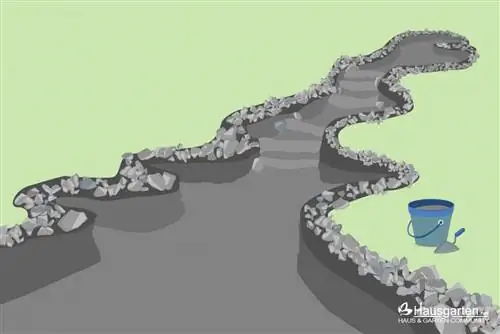
The design
A self-built stream can be beautified, individualized and adapted to the rest of the garden design using various decorative elements. A small waterfall looks particularly appropriate in rock gardens, on Mediterranean properties or in Japanese gardens. There are no limits for your creativity. For example, boulders or other concrete stones can decorate the bank. The do-it-yourselfer can also lay out pottery shards here or build a bridge. It looks particularly pretty when the stream ripples in the glow of solar lighting at dusk.
Tip:
When designing a stream, less is more. A bank decoration that is too lavish appears overloaded, makes maintenance difficult and draws attention away from the waterfall.
However, planting in the bank zone looks most natural. Many varieties feel comfortable near water and some even thrive directly in the garden pond. When choosing plants, the gardener must of course pay attention to the location requirements such as the lighting conditions and sensitivity to waterlogging.
Suitable stones for beautification
After the concrete has been poured, the do-it-yourselfer can immediately give his stream a natural look by placing natural stones in the still liquid pour. Granite, sandstone, bas alt or quartzite harmonize particularly well with a waterfall. Washed pebbles or boulders are also suitable stones to loosen up the overall picture.
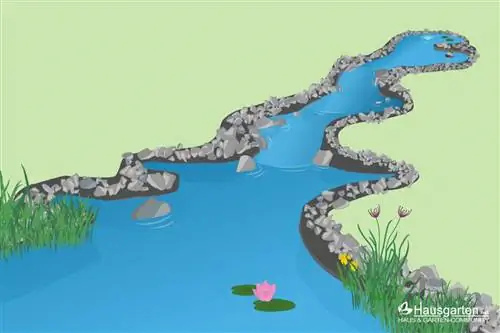
Suitable bank planting
- Günsel (Ajuga reptans)
- Lady's Mantle (Alchemilla mollis)
- Japanese iris (Iris ensata)
- Cuckoo Campion (Lychnis flos-cuculi)
- Meadowsweet (Filipendula ulmaria)
- Waterbird (Eupatorium cannabinum)
- Meadow knotweed (Polygonum bistorta)
- Meadow iris (Iris sibirica)
Suitable aquatic plants
- Bach Honorary Prize (Veronica beccabunga)
- Burning Buttercup (Ranunculus flammula)
- Old swan flower (Butomus umbellatus)
- English water mint (Preslia cervina)
- Heart-leaved frog spoon (Alisma parviflora)
- Pennigwort (Lysimachia nummularia)
- Narrow-leaved cotton grass (Eriophorum angustifolium)
- Swamp forget-me-not (Myosotis palustris)
Note:
A stream in your own garden is an enrichment, especially for animal lovers and insect watchers. Bees and butterflies find food and protection in colorful flowering bank vegetation. Birds like to visit the collecting basin to drink.

